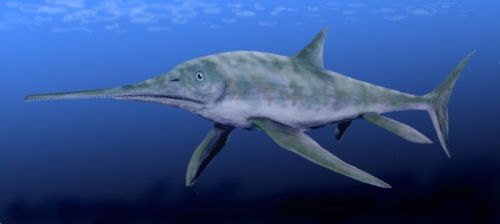
| Palaeos |  |
Ichthyosauria |
| Vertebrates | Temnodontosaurs and Eurhinosaurs |
| Page Back | Unit Home | Unit Dendrogram | Unit References | Taxon Index | Page Next |
| Unit Back | Vertebrates Home | Vertebrate Dendrograms | Vertebrate References | Glossary | Unit Next |
|
Abbreviated Dendrogram
DIAPSIDA |==Younginiformes `-+--+?--Thalattosauria | `--o Ichthyopterygia / ICHTHYOSAURIA | |--Utatsusaurus | `--+--Ichthyosauria | `--+--Merriamosauria | `--+--Euichthyosauria | `--o Parvipelvia | |--Temnodontosaurus | |--Eurhinosauria | `--+--Thunnosauria | `--Ophthalmosauria `--+--LEPIDOSAUROMORPHA `--ARCHOSAUROMORPHA |
Overview |
 |
|
Eurhinosaurus longirostris, an Ichthyosaur from the Early Jurassic of Germany. Illustration by Nobu Tamura, Wikipedia |
By the Jurassic, at level of the Parvipelvia, many ichthyosaurs had developed very large eyes. Temnodontosaurus, one of the most basal Jurassic forms, had some of the largest eyes (26 cm diameter), although this was at least partially a function of its very large size (9 m). From this we may speculate that the one of the distinguishing features of the Jurassic ichthyosaurs was an ability to move off the continental shelves into deep water. Stomach contents of the same species confirm this suspicion. Although Temnodontosaurus had a reasonably varied diet, its menu seems to have been particularly strong in squid which are often found at considerable depth. ATW020517.
Another Early Jurassic group, the Eurhinosauria is harder to make sense of. These ichthyosaurs evolved an upper jaw which was substantially longer than the lower jaw. The overall appearance was thus of a swordfish. The eurhinosaurs appear to have been designed for a very fast, pursuit mode of prey capture.
 |
| Temnodontosaurus platyodon, Early Jurassic (Sinemurian) of England. Length 5 to 9 metres. While highly streamlined relative to earlier forms, this less specialised Parvipelvian had not yet attained the more completely fish-like form of the higher specialised Thunnosaurs such as Ichthyosaurus and Ophthalmosaurus. The fins (paddles) are of the elongate, "longipinnate" type. From McGowan and Motani, 2003 |
Parvipelvia: Hudsonelpidia, Suevoleviathan
Phylogentic definition: last common ancestor of Hudsonelpidia, Macgowania, Ichthyosaurus and all of its descendants.
Range: Late Triassic to mid-Cretaceous
Phylogeny: Euichthyosauria: Californosaurus + *: Temnodontosaurus + Eurhinosauria + Thunnosauria.
Characters: Jurassic ichthyosaurs and transitional forms with mosaic of Jurassic characters (large orbit, notched phalanges on digit I, short postorbital skull, etc). ATW020517.
 Temnodontosaurus:
(= Leptopterygius) T. platyodon, T. eurycephalus.
Temnodontosaurus:
(= Leptopterygius) T. platyodon, T. eurycephalus.
Range: Late Triassic to Early Jurassic of Europe. [C97a]
Phylogeny: Parvipelvia: Eurhinosauria + Thunnosauria + *.
Characters: to 9 m; largest eye ever measured; long, narrow jaw; numerous large teeth set in a dental groove [M97]; fusiform body, triangular dorsal fin; fish-like caudal fin long, rather long, narrow paddles of approximately equal length; stomach contents indicate unspecialized diet, heavy in squid; viviparous.
Image: (right) from the Max Salas Gallery at Prehistorics Illustrated
 |
|
Mounted fossil of Temnodontosaurus trigonodon, Staatliches Museum für Naturkunde Stuttgart. Photo by Ghedoghedo, Wikipedia |
Links: Preparing Mary the ichthyosaur at Charmouth Fossils; Paleontology and Geology Glossary: Te; Dinosaurs: Model & Collectible Pricelist (see image at right); marinhos.htm (Spanish); BBC News | SCI/TECH | Monster eyes from the deep; temnodon; Diets; Eyes; An overview of the Jurassic Cliffs in Dorset; ??? (Japanese); Untitled Document (T. risor is a juvenile of T. platyodon); ??????(????) (Japanese).
References: Callaway (1997a) [C97a], McGowan (1991) [M91]; McGowan (1997) [M97]. ATW030104.
 Eurhinosauria:
Eurhinosaurus, Excalibosaurus, Leptonectes.
Eurhinosauria:
Eurhinosaurus, Excalibosaurus, Leptonectes.
Range: Early Jurassic
Phylogeny: Parvipelvia: Temnodontosaurus + Thunnosauria + *.
Characters: 2-7 m; maxilla elongate and substantially longer than lower jaw; maxilla with teeth along entire length, but directed laterally (as in pristids?)
Comments: A group of large ichthyosaurs which show a tendency towards a swordfish-like elongation of the upper jaw. Eurhinosauria Motani 1999b is rejected by Maisch & Matzke 2000 in favour of LeptonectidaeLinks: Eurhinosaurus; eurhino (German); Charitable Trust Artifacts; Excalibosaurus; ¿¡¿ì¸®³ë»ç¿ì·ç½º (Korean); English.
References: McGowan (1995) [M95]. ATW020517.
| Page Back | Unit Home | Page Top | Page Next |
checked ATW050512